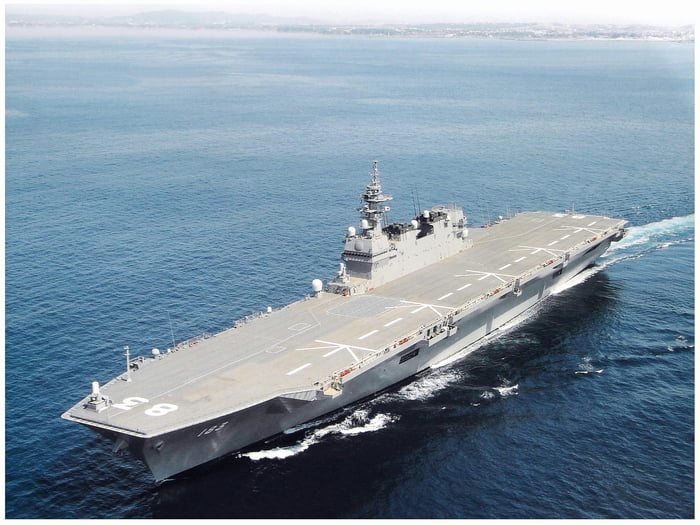Japan is expected to announce new defense guidelines next week that would transform its newest warship into an aircraft carrier for F-35s in order to pave the way for a purchase of 147 F-35s, Keitaro Ohno, LDP’s parliamentary vice minister for defense said on December 12th.
This would mark a major-shift in the post-war makeup of Japan’s Maritime Self Defense Forces. The JS Izumo helicopter destroyer is to be converted into an aircraft carrier that would carry the F-35 vertical takeoff joint strike fighter.
The JS Izumo is the first warship of the Izumo-class military vessels, and it is unclear if future models would carry military helicopters or fighter jets.
Keitaro Ohno said that transforming the JS Izumo would not be expensive, since it already has the basics to support the vertical takeoff fighters. However, purchasing 147 F-35s to outfit the future aircraft carrier and replace Japan’s fleet of F-4 and F-15s will cost a fair bit. Ohno said that about 40 of the aircraft would be F-35Bs for the Izumo, and 107 would be F-35As to replace the F-4s and F-15s.
Specifically, Japan would purchase 47 F-35A to replace all of its F-4s. Out of Japan’s 200 F-15, Ohno said that 100 will be kept and upgraded, while the other 100 will be replaced with a combination of F-35As and F-35Bs.
Japan’s force, since World War II has been primarily for self-defense. However, following the devastating earthquake and tsunami of 2011, the country increased the range of its military engagement to support regional humanitarian missions.
The transformation of the JS Izumo represents a shift in Japanese military capability. This has been a sensitive political topic domestically, as Japan’s post-World War II constitution forbids it to assume an offensive security posture. The ruling Liberal Democratic party and the Komeito party, a coalition partner, reached agreement on the ship modifications December 11th. The parties agreed that the upgrade of the warship will not breach Japan’s pacifist constitution.
In February 2018, Sputnik reported that the JS Izumo had been “secretly designed” for fixed-wing aircraft takeoff and landing (STOVL) operations, citing an unnamed retired Japan Maritime Self-Defense Force executive. According to him the JS Izumo and the same class JS Koga, were both primed for F-35B operations. Japanese Defense Minister Itsunori Onodera at that time denied any efforts regarding such retrofitting.
The Diplomat reported the following regarding the decision:
“The Izumo was originally designed as a multipurpose escort ship, so it wouldn’t pose any threat to other countries if fighter jets are deployed on it,” Defense Minister Takeshi Iwaya was quoted as saying by The Japan Times on December 11. Iwaya also reiterated that the warship would not be an “attack aircraft carrier” capable of offensive military operations. Furthermore, to assuage its junior coalition partner, Komeito, the ruling Liberal Democratic Party stressed that the F-35Bs operating from the JS Izumo’s flight deck cannot serve as long-distance attack platforms given that the JSDF lacks mid-air refueling capabilities. Additionally, no F-35B squadron is expected to be permanently assigned to the new carrier.
The fundamental shift in Japan’s need to defend itself are mostly out of strategic concern, regarding China’s rapidly expanding reach in the Pacific, according to Takeshi Iwaya, Keitaro Ohno and other military and government officials.
There is “no need for us to operate such an aircraft carrier if we don’t have to respond to China,” Ohno told U.S. reporters visiting Japan as part of a week-long study program sponsored by the Sasakawa Peace Foundation.
The “Self Defense Forces in the past were [just about] existence,” Ohno said. “Existence can have a strong deterrent.”
“Now we have to meet the real situation,” Ohno said. “We have to respond to China in the Pacific.”
Furthermore, North Korea also appears to be a concern for Japan, since missiles during its tests fly directly above Japanese territory.
Japan is also actively attempting to boost its military strength. In August 2018 it increased the maximum age for recruits. Due to the aging population the number of soldiers in the country is dwindling.
In May 2018 Japan also increased its military spending for the 6th consecutive year.
Japan announced that it is looking to expand its amphibious skills as early as in 2015, mostly for disaster relief, but also to possibly defend its small islands in the East China Sea that it controls but that China claims as its own.






